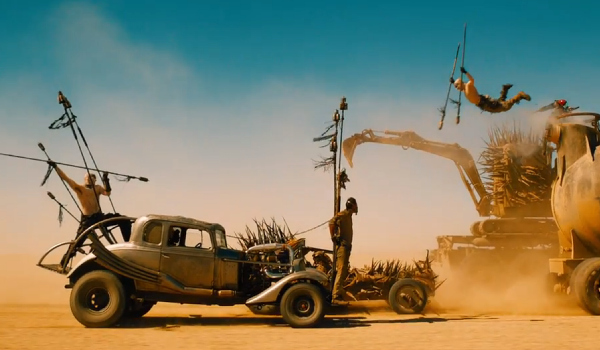There are few things more cinematic than cars, and even fewer things more cinematic than a car chase.
We talk about “car chase movies.” What’s your favorite car chase movie? The French Connection? Or perhaps, like me, you’re more of a To Live and Die in L.A. fan. Maybe you like seeing Burt Reynolds crash into bales of hay, or you prefer James Bond going underwater in a oil crisis-era monstrosity. The Fast & Furious movies has made billions of dollars worldwide, with nothing holding all of them together excepts the idea that it is very exciting to watch cars go fast in cool locations. And most recently, reviewers and to a lesser degree audiences, have gone downright batty over George Miller’s rebooted post-apocalyptic car chase riff Mad Max: Fury Road.
What is it about these car chases that excites us, gets our engines firing?
I would argue that it’s because cars and movies are linked, inseparably, and have been since as long as they’ve both been around.
Just look at what we call them. Think about how “motion pictures” and “automobiles” are related. The industrial magic that created both movies and cars fundamentally revised the way humans experience things they’d long been familiar with. The moving picture. The automobile. The thing which should not move but does. It’s little wonder then that these two innovations went on to define the 20th century, perhaps the fastest-moving of any so far in human history.
The car and the movie bridge the once insurmountable distances that have kept people apart by means of sheer geography. The car takes you somewhere you can’t have otherwise gone. The film shows you things you couldn’t have otherwise seen. These are both products of a go-go era when the world got both smaller and larger, all at once.
The first automobile was created in 1886 in Germany by a man named Karl Benz. The first motion picture was likely made by a Frenchman called Louis Le Prince in 1887. It was called “Man Walking Around a Corner.” Already, the cinema’s capacity for capturing objects in motion, perhaps even in pursuit, is evident. Chases will come in good time, of course. Both these inventions were birthed out of the Industrial Revolution, nursed in Europe, and raised to maturity in the United States, their histories as mobile as their properties.
We talk about our favorite car chase movies because there are no “car chase books” or “car chase plays.” When was the last time you heard of a good car chase poem? The idea is ludicrous. The car is a mobile thing, but oddly enough, it remains static with regards to the medium in which it thrives. The automobile rests in the motion picture. It is its cradle, and its grave. Or maybe more appropriately, its garage.
And when Furious 7 continues to smash records and sell out theatres, just remember that what’s happening isn’t part of a new wave. It’s part of a long history. A history that must keep moving.


